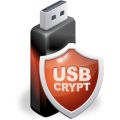Cada día ofrecemos un programa licenciado GRATIS que de otra manera tendrías que comprar!

Giveaway of the day — USBCrypt
USBCrypt estaba como Giveaway el día n 3 de junio de 2010
USBCrypt es una utilidad de software de cifrado de gran alcance que puedes utilizar para proteger con contraseña tu USB y otros dispositivos removibles y fijos con una fuerte encriptación AES. Las unidades de cifrado puede ser utilizadas con otros equipos que no tengan instalado el software USBCrypt.
USBCrypt puede proteger a cualquier puerto USB, flash o unidad flash compatible con Windows. Las unidades de protección se pueden utilizar para almacenar todo tipo de archivos y documentos: textos, hojas de cálculo, archivos financieros, videos, MP3, etc La opción de crear una clave de "repuesto" de archivo, que se utilizará en caso de que olvides tu contraseña, también está disponible.
The current text is the result of machine translation. You can help us improve it.
Requerimientos del Sistema:
Windows 7/Vista/XP/2000 (x32 and x64)
Publicado por:
WinAbility Software CorpPágina Oficial:
http://www.winability.info/Tamaño del Archivo:
9.47 MB
Precio:
$29.95
Mejores Titulos

AB Commander for Windows 7/Vista/XP/2000/x64 - The next generation dual-panel file manager and Explorer replacement, that helps you work with files and folders quickly and efficiently. Includes a built-in file splitter, folder synchronizer, image viewer, full-featured text editor and more. Highly customizable and user friendly. Free for 30 days (fully functional).

Folder Guard for Windows 7/Vista/XP/2000/x64 - Powerful security and access control utility that you can use to password-protect or completely hide files and folders from other users, control access to files with filters, restrict access to Windows Control Panel, and more. Makes folders invisible to any application, including Explorer, Office, command prompt. Free for 30 days (fully functional).

MySecretFolder for Windows 7/Vista/XP/2000/x64 is an easy to use security utility that can hide or lock with a password a folder on your computer. Other users won't be able to peek into your personal files without knowing the password you've set up. Makes the protected folder invisible to any application, including Explorer, Office, command prompt. Free for 30 days (fully functional).

Comentarios en USBCrypt
Please add a comment explaining the reason behind your vote.
Download and installs easily. Activated automatically... so no hassle there. Seems to work fine in Windows XP SP3 though I haven't got a chance to test encrypting a USB drive yet. I like the fact that you can access the encrypted files even on a PC without USBCrypt as it automatically installs a portable version of itself on the unencrypted part of the USB drive. On Windows-only PC, of course.
A free alternative is TrueCrypt, which has the advantage of being cross-platform and can also run as a portable app from the USB drive itself.
Save | Cancel
#7 - Retell - Some of the programs that we get from GOTD have little programs in them that automatically search for and install updates. It is after this update process that they revert to 'trial' versions and expire on us after a set period of time. Some programs don't do it automatically but will give us a message "New version available"and getting the update will screw us out of the freebie we currently have working on our machine.
# 2 of the terms and conditions (up above) says, "No free upgrades to future versions" yet some programs will, as said, automatically upgrade so you have to check and turn off that function if the program is set for it. Would be nice if the setup instructions would tell us about auto-update and turning it off or if the settings would be 'opt in' as opposed to 'opt out' but they don't so one has to check if the options are available. - Ethical or unethical? That is debatable. I'd prefer they be upfront about it. -
I've lost quite a few good programs through this system but they were free to start with. So it goes. But if the free software does the auto-update with a program that is setting up encryption/passwords and you forget the password... - - Be careful out there.
Be careful out there.
Save | Cancel
Hello everyone, Andrei from WinAbility Software here. First of all, thank you all who voted up for USBCrypt (all 101 of you :-) ) Let me answer some question posted so far:
- If you use the encrypted drive on another computer, the admin right are required (once per Windows session);
- If you plug the drive into a Mac or Linux computer, the drive will remain encrypted, because the software does not run on Mac or Linux;
- If you back up the host drive, the encrypted data will be saved in the encrypted form. If you backup the encrypted files after entering your password, they will be backed up in the decrypted form.
If you have other questions, please note that although this promotion does not include the standard technical or customer support we usually provide, we've set up a special Facebook page for the GOTD customers:
http://www.facebook.com/pages/Encryption/115647851807099
Please feel free to post your comments or questions on the Wall or within the Discussions tab, and we will try to answer your questions there.
Thanks again!
Save | Cancel
At the moment the rating is 66 (34%) thumbs up, # 129 (66%) thumbs down, and yet there are no negative comments.
Would someone who has given it the thumbs down please explain what's wrong with it, or whether it's simply because they don't want it.
Save | Cancel
USBCrypt creates an encrypted virtual disk on the target drive, & adds a mini-copy of itself to the drive so it's usable on PCs/laptops without USBCrypt installed -- the software copied to the encrypted drive includes both 32 & 64 bit versions, & is only for opening the encrypted virtual disk [it can't encrypt another drive]. The developer provides a manual on their site, including a printable version that comes in handy using PDFCreator [or some other PDF print driver] -- [winability.com/usbcrypt/users-guide-printable.htm]. This manual recommends removing all files from a USB drive before adding USBCrypt, & this is repeated during install -- the USB stick I used to test doesn't have a partition structure that's compatible with Paragon or EASEUS partition software, so I couldn't track whether partitioning was effected or not, but I'd suggest following the developer's advice & backing up any hard drives before using USBCrypt to add an encrypted virtual disk to a hard drive. Since that partial copy of USBCrypt is added when you set up an encrypted v/disk you should always have access, but, remember that today's GOTD does not come with or need a key, & the included setup.exe is only good today.
USBCrypt uses the Microsoft Windows Installer, which can & does cause problems occasionally [normally based on how well apps that you've installed previously using the win installer were written -- if WinAbility, the developer, screwed up, it *likely* won't show up until you install something in the future using the win installer]. USBCrypt installs to 2 folders by default under Program Files --> USBCrypt & WinAbility Encryption Driver.10.2.0.1180 ... 2 files are added to the Windows' Installer folder, & [monitored in XP Pro SP3 32] by default password reset files are stored in Documents and Settings\[UserName]\Local Settings\Application Data\USBCrypt. While drivers are added, they aren't placed in the normal Windows folder location, & needed copies are included when you create an encrypted v/disk on a USB stick. Bear in mind that whenever drivers are used that's something else that can go wrong [potential incompatibilities, restrictions on PCs where you try to use the encrypted USB stick etc]. In the registry my logs show both WED1180 & Winability Encryption Driver added to ...ControlSet\Services. Windows' Admin Tools -> Services shows the WinAbility Encryption Driver set to Automatic [i.e. starts with Windows], & it in a nutshell watches for you to insert a USB stick with an USBCrypt v/disk.
During install &/or when you start the app from the Start Menu, the wizard's started to create an encrypted v/disk... when you do, on the USB stick you'll wind up with USBCrypt.exe [double click this to start the encryption/decryption app], autorun.inf [starts that app if autorun is turned on for the PC/laptop you're using], & a folder called: USBCrypt-System. That folder holds 10 program files plus the encrypted v/disk & a file with the same name. You allot however much space to the v/disk when you create it, & the v/disk uses it all -- it does not grow/shrink dynamically. Once the USBCrypt [installed or on-key app] is started you enter the v/disk name & password, & the encrypted v/disk shows up & behaves in Windows Explorer as another drive. Because you're adding another layer between you & your storage device, it will be slower.
The WinAbility Software site has info on the encryption used etc, but not being open-source [which can be independently evaluated], IMHO you shouldn't place as much confidence in USBCrypt as TrueCrypt, plus it doesn't have it's stealth features. That said, TrueCrypt isn't for everyone -- no app is -- so for many PC/laptop users this might be a good alternative. In contrast the similar Wondershare app recently on GOTD [Wondershare USB Drive Encryption] is more light weight, both in terms of features & of it's impact on Windows &/or a USB stick. Personally I'd be more inclined to use today's GOTD for biz purposes, & Wondershare's alternative if I just wanted to keep nosy co-workers, family members, &/or kids out of my stored files.
Save | Cancel